Search the Special Collections and Archives Portal
Search Results
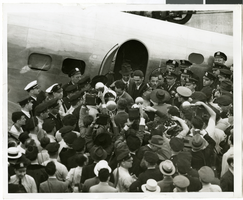
Photograph of crowds at Floyd Bennett Airfield, New York, July 1938
Date
1938-07-14
Archival Collection
Description
The black and white view of Howard Hughes' Lockheed 14 aircraft after performing its final landing on the Round the World flight at Floyd Bennett Airport, New York. Description printed on back of photograph: "Howard Hughes leaving his plane after flight around the world in three days, 19 hours and 17 minutes 7/14/38"
Image
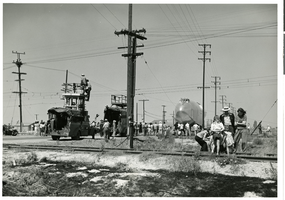
Photograph of crowd witnessing the fuselage of Hughes Flying Boat in transit, California, June 16, 1946
Date
1946-06-16
Archival Collection
Description
Transcribed from stamp on back of photo: "June 16, 1946; Hughes Aircraft Photo." Crowds and policeman watching as a section of Howard Hughes' "Spruce Goose" or "Flying Boat" was being moved (with a police escort) from the Hughes Aircraft plant in Culver City, California to Terminal Island in the Los Angeles Harbor where the plane was assembled June 1946. Notice workers raising the power lines so the fuselage could pass underneath.
Image
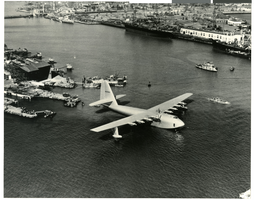
Photograph of the Hughes Flying Boat in the Los Angeles Harbor, California, 1947
Date
1947
Archival Collection
Description
The Hughes Aircraft HK-1 "Flying Boat" floating in Los Angeles Harbor.
Image
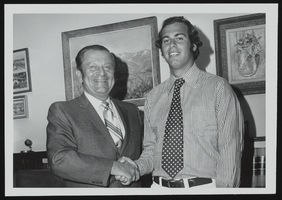
Senate Intern Brian Greenspun with Howard Cannon: photographic print
Date
1980-11-20
Archival Collection
Description
From the Howard Cannon Photograph Collection (PH-00192)
Image
Publications not produced by Hughes Electronics
Level of Description
File
Archival Collection
Hughes Electronics Corporation Records
To request this item in person:
Collection Number: MS-00485
Collection Name: Hughes Electronics Corporation Records
Box/Folder: N/A
Collection Name: Hughes Electronics Corporation Records
Box/Folder: N/A
Archival Component
New York New York Hotel and Casino
Level of Description
File
Archival Collection
UNLV University Libraries Menu Collection
To request this item in person:
Collection Number: MS-00436
Collection Name: UNLV University Libraries Menu Collection
Box/Folder: N/A
Collection Name: UNLV University Libraries Menu Collection
Box/Folder: N/A
Archival Component
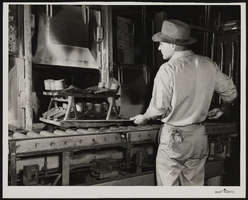
Photograph of a worker at Hughes Tool Company, Houston, Texas, circa 1940s-1950s
Date
1940 to 1959
Archival Collection
Description
Press release attached to back of photo: "A roughneck fits a new Hughes Jet bit into the drill collar preparatory to running the drill stem into the hold. In 1953 more than 500,000 rock bits produced by the Hughes Tool Company of Houston, Texas, were used in the United States alone. The invention of the rock bit by Howard R. Hughes, Sr., made it possible to drill far deeper into the earth beyond the shallow oil deposits which are now practically exhausted. Without rotary drilling equipment of this kind the world might revert to a horse and buggy economy."
Image
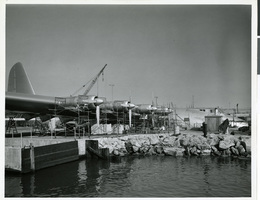
Photograph of Hughes Flying Boat on Terminal Island, during assembly, January 8, 1947.
Date
1947-01-08
Archival Collection
Description
Transcribed from photo sleeve: Howard Hughes' "Spruce Goose" or "Flying Boat" being assembled at Long Beach Harbor. Stamped on back of photo: "Hughes Aircraft Photo" and the date "Jan 8 1947." Los Angeles Harbor, Terminal Island are now known and Long Beach.
Image
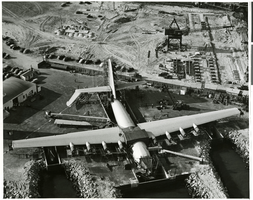
Aerial photograph of Hughes Flying Boat ready for tests, Terminal Island, California, October 13, 1946
Date
1946-10-13
Archival Collection
Description
Press Release attached to photo: "HUGHES HERCULES READY FOR TESTS. LONG BEACH, CAL. An aerial view shows Howard Hughes' giant plywood seaplane Hercules ready for taxi tests at Long Beach. The initial flight of the plane, which cost $20,000,000 and will seat 700 persons, will not be attempted until early in 1947. ACME 10/13/46." Los Angeles Harbor, Terminal Island are now known as Long Beach.
Image
Rea Hopper, Director of the Aeronautical Division, Hughes Aircraft Company; Howard Hughes; Clyde Jones, Director of Engineering, Hughes Tool Company Aeronautical Division; Warren Reed; Colonel Carl E. Jackson, Air Research and Development Headquarters, Baltimore; Gale J. Moore, pilot; and unidentified pilot in front of the experimental helicopter XH-17 Flying Crane, 1952 October 23
Level of Description
File
Archival Collection
Howard Hughes Professional and Aeronautical Photographs
To request this item in person:
Collection Number: PH-00321
Collection Name: Howard Hughes Professional and Aeronautical Photographs
Box/Folder: Folder 08
Collection Name: Howard Hughes Professional and Aeronautical Photographs
Box/Folder: Folder 08
Archival Component
Pagination
Refine my results
Content Type
Creator or Contributor
Subject
Archival Collection
Digital Project
Resource Type
Year
Material Type
Place
Language
Records Classification
